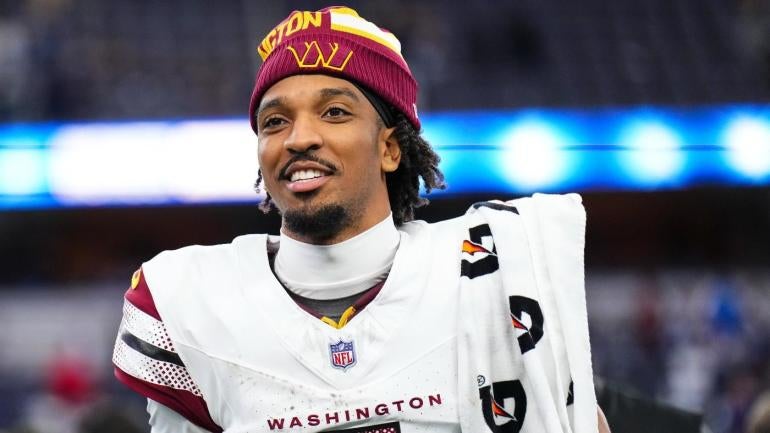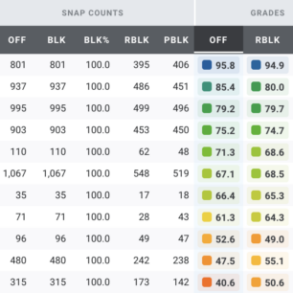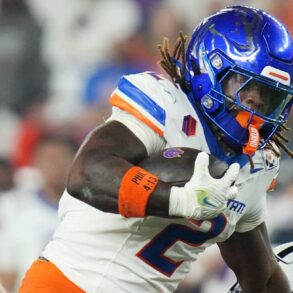
The 2024 first-round rookies have completed their debut seasons in the NFL. Some hit a rookie wall. Some flourished in key roles as first-year players. And a handful didn’t play much — or at all — because of injury. The offensive linemen mostly struggled. The receivers mostly shined.
It’s time to rank the Round 1 picks from the 2024 NFL Draft with their collective Year 1 in the books.
(Since Vikings QB J.J. McCarthy suffered a season-ending injury in the preseason, there are only 31 first-year players ranked below.)
An injury curtailed Robinson’s rookie year in the desert before it started, and he only appeared on 184 snaps for the Cardinals defense. Of those snaps, 120 were pass-rushing opportunities, and the former Missouri star mustered a mere two pressures. Yikes.
Fautanu barely played as a rookie in Pittsburgh. He played 55 snaps in Week 2. That was it. Stupid preseason injuries. The knee ailment he suffered in August flared in September, and he was placed on injured reserve soon thereafter. Fautanu didn’t consistently move defenders in the run game and allowed two pressures on 29 pass-blocking snaps in his lone game of 2024.
Another rookie blocker hamstrung by injuries in Year 1 as a professional. He played right guard (and a little left guard) for a mere 155 snaps and didn’t get on the field after Week 9. The former Arizona brick wall surrendered seven pressures on 104 pass-blocking opportunities as a rookie, which doesn’t indicate he was a huge liability but doesn’t represent a stellar showing.
Guyton had to fill enormous cleats in Dallas — Tyron Smith’s at left tackle. He played nearly 700 snaps and clearly wasn’t quite ready for the power NFL edge rushers can bring on every snap. He allowed six sacks and 26 total pressures on close to 440 pass-blocking snaps. Not brutal. Not fantastic.
Turner was one of the younger players in the 2024 draft class, and it took him ample time to acclimate to the speed and power of the NFL. In a backup/specialty role, Turner amassed just 12 pressures on 144 pass-rush opportunities in Brian Flores’ blitz-happy defense. He sunk in coverage more than what he was accustomed to at Alabama and made a splash play or two against the run.
26. Olu Fashanu, OT, Jets
Fashanu wasn’t forced on to the field right away as a rookie because of the presences of veteran acquisitions Smith and Morgan Moses on the edges of the Jets front. That probably helped Fashanu. Once the coaching staff plugged the youngster at left and later right tackle, he mostly looked the part. He was hardly a brick wall but moved emphatically and accurately to the second level for the ground game and allowed 23 pressures on 372 pass-blocking snaps.
Despite an injury past and dealing with injuries as a rookie, Mims logged 835 snaps on a dynamic Bengals offense in Year 1 and was thrust into heavy pass-blocking assignments protecting Joe Burrow. The speed and bendiness he faced on a regular basis wasn’t completely overwhelming for him. Allowing 33 pressures on 560 pass-blocking opportunities was respectable. I thought he’d be more of a people-mover in the run game at his gigantic size.
Murphy was as advertised as an up-the-field rusher with 21 pressures on 244 pass-rushing snaps. Anything close to a 10% pressure-creation rate for a defensive tackle is what most are realistically aiming for. And just like Murphy did at Texas, he played much larger than his size against the run. He only missed two tackles all year, but his 17 stops were only tied for fifth among interior defensive linemen. With an expanded role in 2025, Murphy should emerge as a weapon on defense for Mike Macdonald.
What a tremendous comeback for Pearsall, who was shot just weeks before the regular season began and went over 100 yards in Week 17’s firework-laden outing against the Lions. His unprecedented circumstances hindered his ability to make a sizable impact during his rookie season. When healthy, he looked like he could reasonably hold his own as a full-time starter with crisp routes and reliable hands, particularly in traffic.
The Titans offense was an abomination in 2024, finishing 30th in EPA per drive (non-garbage time) and taking the seventh-most sacks with 52.
And Latham ran very hot and cold. The brutally strong blocker had some dominant games and outings in which he was overwhelmed by speed and flexibility around the corner. He gave up 47 pressures on 660 pass-blocking snaps.
Arnold struggled for much of his rookie season. I respect how hard he battled, and that persistence did lead to some splash plays for Detroit’s injury-plagued defense. He had 10 pass breakups and 60 tackles but allowed four touchdowns in his coverage area.
The Saints dealt with more injuries to key components of their offense than any team in the NFL, and Fuaga was one of the steadying forces in his debut NFL season. The nimble yet massive blocker gave up just 39 pressures on 657 pass-blocking snaps and was rarely outmuscled on running plays.
Barton logged over 1,000 snaps as Tampa Bay’s center as a rookie and didn’t ever look significantly out of place. Centers don’t typically allow as many pressures as perimeter blockers, and Barton’s 23 pressures on 651 pass-blocking snaps indicates a strong start to his pro career at the pivot.
18. Xavier Leggette, WR, Panthers
Legette had an opportunity to disrupt the seeding in the NFC playoffs in the final minutes of a battle against the Eagles in Philadelphia but dropped the potential game-winning touchdown in that contest. Drops (eight) plagued the former South Carolina star. As expected, he was a force after the catch, with eight forced missed tackles on just 49 receptions.
Drake London came alive once Penix took the reins in Atlanta. Imagine that. If only the switch was made sooner for the Falcons. Penix had classic rookie moments in his mini audition in the final month of the season. There were encouraging glimpses, too. Sample size must be considered here, but the 9.0% Big-Time Throw rate was as gargantuan as his 1.7% Turnover-Worthy Play rate was tiny.
Penix did work through ball-placement issues reasonably well, and played like a very mature rookie thrust into action for a club in the middle of a divisional race.
Didn’t hear much from Latu as a rookie, did we? Not so much. Altogether, he had a solid year on an up-and-down Colts defense. He finished with a pressure-creation rate of 10.7% — 38 pressures on 375 pass-rushing opportunities. High-caliber edge rushers teeter closer to 14 to 16% with elite-level players nearing 20%.
Latu wasn’t heavily involved in Indianapolis’ run-stopping efforts, with just 32 tackles on the season, yet he did muster five tackles for loss. A good but far from spectacular debut season for the Colts’ first-round selection.
Chicago’s aerial attack was conservative and rarely a well-oiled machine. Odunze looked lost to begin his first NFL season but then became one of Williams’ favorite targets down the stretch, with 61 of his 96 targets coming after Week 8’s season-altering loss to the Commanders.
Odunze quietly finished with 734 yards and three receiving touchdowns and, completely on-brand from his draft profile, operated like an All-NBA power forward rebounding in traffic, going 13 of 18 in contested-catch scenarios.
While not overly efficient down the field — catching only three of 17 long-ball targets — Worthy was an intermittent spark plug for Kansas City’s offense in 2024. After the multiple-touchdown effort in the victory over the Ravens to begin the year, Worthy sprinkled in a touchdown every other week or so, finishing with six receiving scores in his first regular season in Kansas City.
While he never registered an 100-yard receiving game, Worthy did force six missed tackles on 59 receptions and went over 50 yards on four separate occasions, including his final two appearances in 2024.
Maye did more than enough to inspire confidence in the future of the quarterback position in New England. Was he perfect? No. His BTT and TWP rates were almost identical (3.7% to 3.5%). But there were glimmers of functional mobility and a veteran-like knack for ad-libbing when open options were limited, as he averaged 7.8 yards per rush as a rookie.
The arm strength, the pocket presence, the downfield strikes — they all appeared at times in 2024 for Maye. He just often tried to do too much.
At 21 years old, Wiggins rocked in Baltimore’s defense as a rookie. A splendid fit for a club that needed outside cornerback stability. He played with his hair on fire all season — when healthy — and finished with 13 pass breakups, one pick and 33 tackles on 60% of Baltimore’s defensive snaps. He wasn’t caught out of position often and was feisty when targeted. Just 50% of those targets were caught in 2024.
As the first blocker off the board — selected by Jim Harbaugh — the highly decorated Alt entered the NFL with lofty expectations. He may have fell slightly short of meeting them. Yet by all measures, he had an ultra-steady rookie season at right tackle opposite stud Rashawn Slater on Los Angeles’ offensive line.
Despite his towering frame, he worked well grappling with edge rushers and linebackers at the second level on run plays. On passing downs, Alt had answers for what just about every outside rusher threw at him. He allowed a mere 20 pressures on 602 pass-blocking snaps. With his supreme athletic gifts, the future is incredibly bright for Alt.
Williams, individually, played better than Chicago’s record would indicate. Yes, he absolutely took far too many sacks and hits in the pocket. His 68 sacks were the most in the NFL. And a 10.7% sack rate is not sustainable if he’s going to be successful with the Bears.
Yet, Williams bounced around in the pocket and routinely flashed his live arm from an array of arm angles in his rookie season. He did throw 20 touchdowns to just six interceptions. Could he and the Bears have demonstrated a better understanding of specific game situations? Without question. But Williams’ season as a thrower and improviser was good. His 3.9% Big-Time Throw rate was the same as Jayden Daniels‘. Getting the ball out of his hands quicker will be key to his Year 2 development.
9. Marvin Harrison, WR, Cardinals
Harrison didn’t quite meet the hype in his rookie season. In fairness, the hype was stupidly high to begin with. In somewhat of a “disappointing” year relative to not just the expectations but his classmates, MHJ still finished with 885 yards and eight receiving touchdowns for the Cardinals. Only Brian Thomas Jr. caught more touchdowns among rookie receivers. He only forced one missed tackle all year and wasn’t dominant in those famed contested-catch scenarios.
Harrison had 10 catches on throws made 20-plus yards downfield, which is exactly what he was known for at Ohio State. That figure was the second-most among rookies and tied for 11th among all wideouts.
Mitchell quietly went about his business as a rookie in Philadelphia’s defense on the boundary: no interceptions, but 12 pass breakups, and he allowed a reception on just 58% of the targets in his coverage area. It didn’t matter if he was tested deep, on intricate routes at the intermediate level or underneath. The former Toledo Rocket stayed pinned to opposing receivers and played the football when thrown his way. He has serious No. 1 CB potential with the Eagles and often played like one as a rookie.
Nix wasn’t perfect as a rookie, but he was an exquisite orchestrator of Sean Payton’s scheme during Denver’s 11-6 season that clinched the final playoff spot in the AFC. Nix had a minute sack rate of just 4.0%, and his pressure-to-sack rate of 13.3% was the eighth-lowest among all qualifying passers. Turnover-Worth Play rate-wise, Nix’s 1.9% was the same as Joe Burrow’s and tied for sixth-lowest in the NFL. As the season wore on, he started to make more connections downfield. Nix played like someone with more than 60 collegiate starts under his belt.
No way Robinson sniffs the top 10 in the rookie rankings based on the first half of his debut NFL season. The second half of it? Borderline NFL Defensive Rookie of the Year-caliber. From Week 8 on, the former Penn State stud accumulated 48 of his 56 rookie-year pressures, including six contests with four of more pressures generated. The recently turned 22-year-old rusher absolutely flashed down the stretch when many rookies hit the rookie wall.
Nabers had essentially nothing around him with the Giants — a shoddy array of quarterbacks who operated behind a porous offensive line, and no real secondary option to draw attention away. Still, he finished second among rookie receivers with 1,204 yards but cruised to the rookie lead in receptions with 109.
That’s because Nabers created for himself. He forced 19 missed tackles, which tied for the fifth-most among all receivers. He was a dynamic route runner at all three levels and went nearly 50% (18 of 39) when needing to make a contested-catch.
4. Brian Thomas Jr., WR, Jaguars
I can’t get over how sensational BTJ was in Jacksonville, especially given he played with Trevor Lawrence for 10 games — and Lawrence had his least-effective season to date in the NFL. Thomas finished with four 100-yard contests and a yards-per-route run figure of 2.45, directly between Mike Evans (2.40) and Justin Jefferson (2.50). YPRR isn’t the be all, end all of receiving metrics, yet it’s a darn-good measure of efficiency.
He also finished third among all receivers with 1,282 yards — which was first among rookies — and scored 10 touchdowns with Lawrence and Mac Jones throwing him the football and minimal help by way of an established veteran presence after Christian Kirk went down midway through the season. All-Pro caliber debut for Thomas.
Verse is going to win the NFL Defensive Rookie of the Year award. And he should. Khalil Mack vibes emanated from Verse all season. He had 77 pressures in the regular season, a silly amount for a first-year pro. And that figure wasn’t the byproduct of solely high volume. Verse finished fourth among edge rushers in pressures on just the ninth-most pass-rush snaps. He finished top-10 among edge rushers with 35 stops, too.
Verse played like an in-his-prime veteran in Year 1 for the Rams.
All Bowers did was set the all-time rookie receptions record with 112 snags in his first NFL season. And only Amon-Ra St. Brown (115) and Ja’Marr Chase (127) had more catches than the Las Vegas tight end. Midway through the season, much more attention was focused on him in the aftermath of the Davante Adams trade. It didn’t matter. Bowers had his two 100-yard games after Adams was on the Jets and caught at least three passes for at least 30 yards in all but one game during his rookie season. He wasn’t supremely elusive after the catch, with just four missed tackles on the year, but routinely got open and only had four drops while converting 53.3% of his contested-catch opportunities.
1. Jayden Daniels, QB, Commanders
The future NFL Offensive Rookie of the Year was the heartbeat of the vast franchise revitalization in the nation’s capital. Daniels delivered the football with supreme accuracy all season — not just by rookie standards — played with calmness in the pocket beyond his years, and finished second to Lamar Jackson with 864 yards on the ground. His 79.1% adjusted completion rate was fifth in the NFL among qualifiers, and he was one of six quarterbacks with a Turnover-Worthy Play rate of under 2.0% (1.7%).
Daniels wonderfully blended a lightning-quick release with exquisite creativity after holding the football on off-structure plays en route to a 12-win regular season for Washington and the No. 1 spot here.
This post was originally published on this site be sure to check out more of their content.
































































